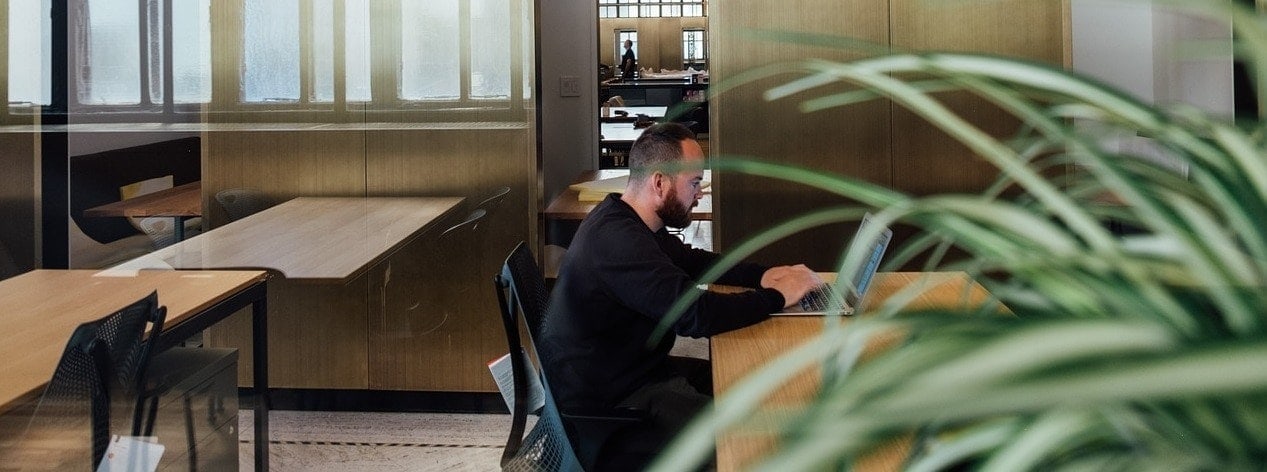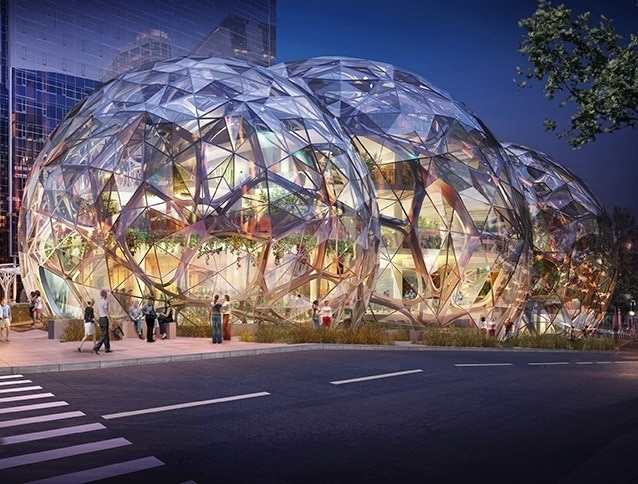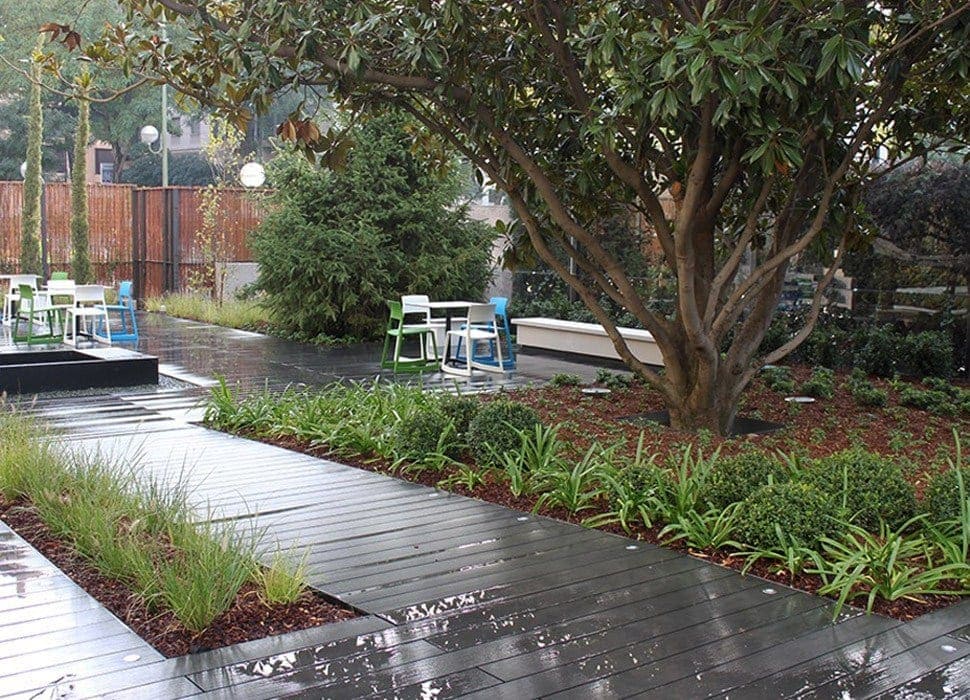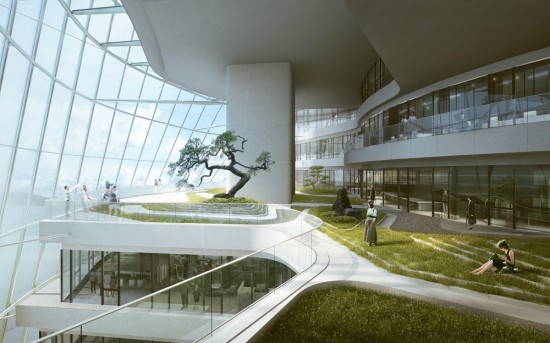
Amazon’s new headquarters in Seattle will be practically an indoor forest greenhouse. Behind the visible spheres of the external architecture, Amazon is looking to use the inside to create natural spaces which will inspire its employees.
When it opens in early 2018, the headquarters will be packed with a plant collection worthy of top-notch botanical gardens.
And it is not the only large company going for this new office model. The future of work, according to Google, will take place in forests and wildflower meadows, next to streams and green areas, amongst bike lanes and yoga classes and water fountains, with fresh produce to hand. And WiFi connection, of course.
And so it is designing its new headquarters as a way of working among nature, with office modules draped with vines and climbing plants, allowing staff to work with their laptops beneath the trees.
These are only a few examples of the many large companies increasingly committing to having veritable gardens in their offices.
A park? No, it’s actually my office
But it’s about a bit more than just fashion. “The availability of green areas increases employee engagement, making them more physically, cognitively and emotionally involved in their work”, says Francisco Vázquez, president of 3G Smart Group, a company specialising in office design (such as Microsoft’s new offices in Spain). This is because plants “can help to reduce stress, increase attention skills and improve general wellbeing, all of which in turn increases productivity,” he adds.
Stress is, in fact, something very common in the workplace. According to the CBRE report “Wellness in the Workplace”, 79% of employees surveyed say that balancing private and professional commitments is a cause of stress, while a very similar percentage, 80%, claim that wellness programmes would be crucial for retaining them and keeping them motivated over the next ten years.

Source: http://www.nbbj.com/news/2013/10/25/approval-of-amazoncom-covered-by-los-angeles-times-gizmodo-and-the-cbc/
Can these green spaces in the workplace have a healing effect? According to research by Elizabeth Nelson, from the University of Twente, the answer is yes, since the addition of plants to the work environment brings with it multiple benefits, such as, for example, fewer headaches, reduced depression levels, and improved concentration, self-discipline and physiological stress.
The effect of looking at ourselves in the mirror
The fact that well-known names such as Facebook, Apple or Amazon are placing a huge importance on outdoor green areas in their new headquarters also creates a “mirror effect, pushing other companies to take the step, even going as far as to prioritise landscape over architecture,” according to Andrea G. Padín, an architect at La Habitación Verde.
Bringing green spaces and green areas into offices is not something that happens only in the US. Spanish power company Enagas’ corporate offices already have carefully-designed outdoor spaces, the aim of which, explains Andrea G. Padín, is “to provide workplaces, of course, but also spaces for interaction and representation, for working in meetings and as a team, or spaces in which to organise events large or small”.

Enagás offices. Source: La Habitación Verde http://lahabitacionverde.es/portfolio-items/paisajismo-oficinas-enagas/
Beyond environmental benefits
As we can see, reducing stress levels and improving the working environment – which also helps to increase competitivity – are the main arguments in favour. “They reduce stress, help to maintain enthusiasm, and promote patience. They improve thermal and noise control and provide a soothing view when located in open spaces. They aid smooth relationships and informal conversations. They are a source of relaxation, creating a good atmosphere and a sense of comfort, which impacts directly on employees,” says Vázquez.
But there are also environmental impacts from the introduction of green spaces into our offices. “Plants reduce pollution levels, help control temperature and noise levels” – in addition to being ornamental – “and improve the aesthetics and representativeness of a company,” Padín adds.
For all these reasons, experts believe that it is a feasible proposition for all types of companies. “Every company can incorporate this model, scaling it according to its size and the resources available. What is important is the decision to bring such spaces into the office, so that offices are brought out of their current state of general neglect,” explains the head of La Habitación Verde.
Moreover, as Vázquez reminds us, not everything has to be “plants”. “There are other types of vegetation, such as ‘stabilised’ mosses and lichens where the plant sap is substituted for a glycerine-based substance, or natural branches, rubber or cork, which can be used more easily in small areas. For larger offices with outdoor areas or terraces, traditional inspiration can be sought using shade and water elements. Some companies have gone as far as to provide vegetable gardens for employees in patios and terraces, so that they can grow their own plants and fruits.”
The first steps to a green space
When we asked the experts what advice they would give to companies thinking of setting up their own green spaces, 3G Office recommended consulting professionals to choose the best spots within the office and the appropriate scale of intervention; involving employees in the project so that they are able to customise their own areas; considering what lighting will be available for the plants, whether natural or artificial; and shying away from outmoded solutions such as potted plants, bamboo, cacti or artificial plants.
The aim, in the words of Andre G. Padín, is that this must be an addition to existing offices, “keeping up the company image with an appropriate design and coming up with spaces which provide an alternative to those that already exist; ensuring flexibility so that any new green areas can grow with the company; and ensuring cost-effectiveness in relation to maintenance, so that they fulfil their representative function without being a significant burden”.
According to the architect, a good green space within an office should be balanced and in proportion. “Large-scale green projects can be implemented in access areas, waiting rooms and halls, with smaller plants being used in closed working areas.” Plants used should be safe (i.e. not causing allergies) and not excessively perfumed.
The cost of this new office model will very much depend on the area and the design, but “in general, investments are quickly considered to be positive given their results,” says Andrea G. Padín.






There are no comments yet